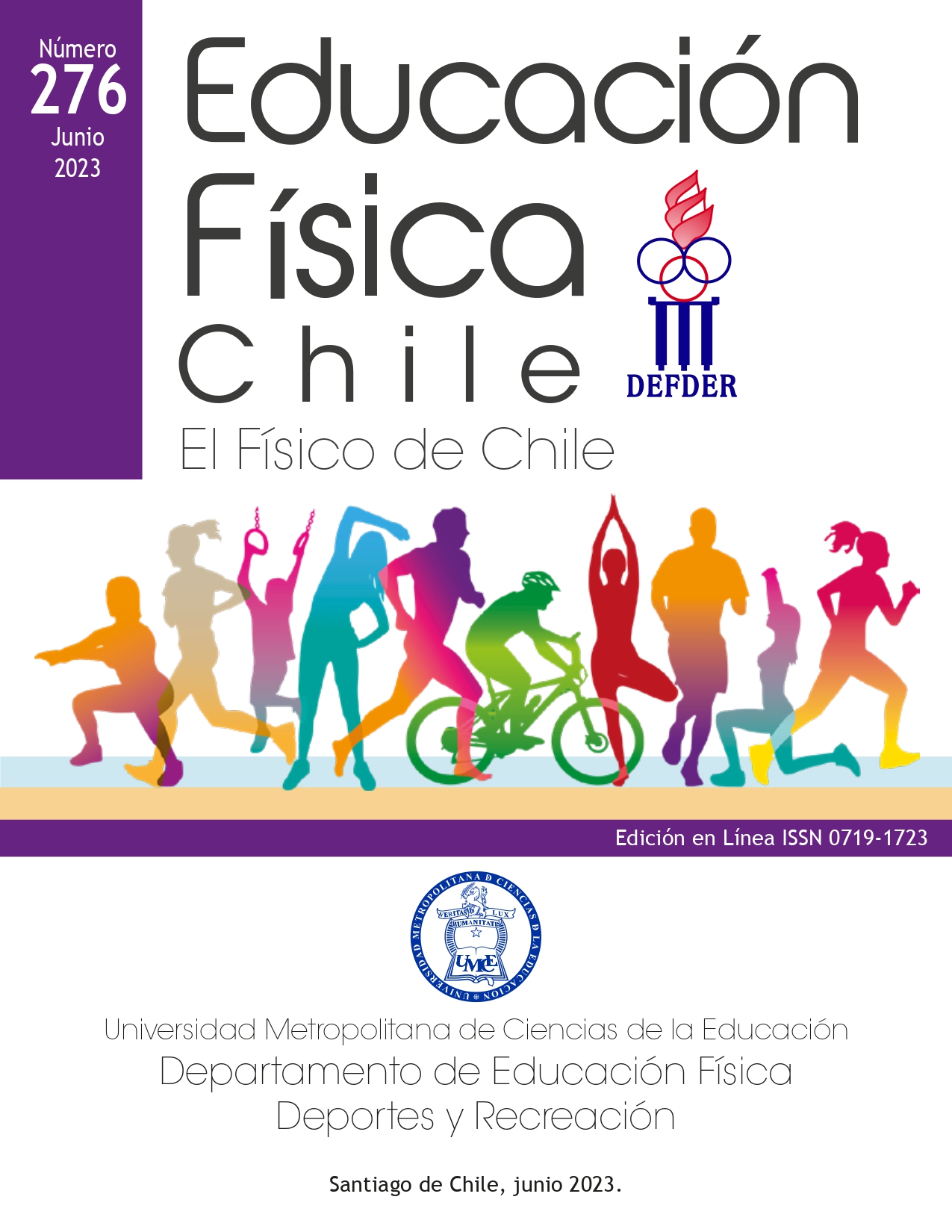Main Article Content
Jul 6, 2023
Abstract
Objective: To evaluate the effects of a physical education program using Mexican sign language in students with hearing disabilities on motor coordination development. Method: A quantitative approach was used, with a quasi-experimental design, the program was implemented for 20 weeks using the Mexican sign language and a series of didactic strategies with expected learning towards the development of coordination capacities, the impact of the program was evaluated in 27 students with disabilities before and after using the KTK test: Körperkoordinationstest für Kinder by Kiphard and Schiling. Result: Statistically significant differences were evidenced before compared to after the intervention in the motor quotient using the mixed 2 x 2 analysis of variance (ANOVA) test. Conclusion: it is possible to infer that from physical education the present program is a positive strategy for the improvement of motor development in students with hearing disabilities.
References
Hall-López, J. A. (2021). Programa de formación educativa para aumentar el índice de actividad física moderada a vigorosa en profesores de educación física. Retos, 39, 192–199. https://doi.org/10.47197/retos.v0i39.78014
Hall-López, J. A., & Ochoa-Martínez, P. Y. (2023). Brecha de género en la participación de tareas motrices de educación física. Retos, 48, 298–303. https://doi.org/10.47197/retos.v48.96976
Kiphard, B. J., & Schilling, F. (1974). Korperkoordinationstest für Kinder. Weinheim:Beltz Test GmbH.
Kitterick, P. T., Lucas, L., & Smith, S. N. (2015). Improving health-related quality of life in single-sided deafness: a systematic review and meta-analysis. Audiology & Neuro-otology, 20(S1), 79–86. https://doi.org/10.1159/000380753
Li, C., Haegele, J. A., & Wu, L. (2019). Comparing physical activity and sedentary behavior levels between deaf and hearing adolescents. Disability and Health Journal, 12(3), 514–518. https://doi.org/10.1016/j.dhjo.2018.12.002
McLennan, N. & Thompson, J. (2015). Educación Física De Calidad (EFC): guía para los responsables políticos. Organización de las Naciones Unidas para la Educación, la Ciencia y la Cultura UNESCO. Disponible en: https://unesdoc.unesco.org/ark:/48223/pf0000231340
Melo, R., Lemos, A., Macky, C. F., Raposo, M. C., & Ferraz, K. M. (2015). Postural control assessment in students with normal hearing and sensorineural hearing loss. Brazilian Journal of Otorhinolaryngology, 81(4), 431–438. https://doi.org/10.1016/j.bjorl.2014.08.014
Ochoa-Martínez, P. Y., Hall-López, J. A., & Teixeira, A. M. (2022). Physical activity during school recess and physical education among deaf school children. Revista Brasileira De Educação Especial, 28(e0112)49-56. https://doi.org/10.1590/1980-54702022v28e0112
Ochoa-Martínez, P. Y. (2022). Educación física en niños con discapacidad auditiva. Editorial de la Universidad Autónoma de Baja California. México. Ochoa-Martínez, P. Y. (2021). Experiencia didáctica en educación física para la mejora de actitudes hacia la discapacidad auditiva en futuros profesionales de la actividad física y deporte. Retos, 40, 174–179. https://doi.org/10.47197/retos.v1i40.81296
Ochoa-Martínez, P. Y., Hall López, J. A., Carmona López, A. A., Reyes Castro, Z. E., Sáenz-López Buñuel, P., & Conde García, C. (2019a). Análisis comparativo de un programa educación física en niños con discapacidad auditiva sobre la edad motora equivalente. Retos, 35, 310–313. https://doi.org/10.47197/retos.v0i35.67190
Ochoa-Martínez, P., Hall-López, J., Carmona López, A., Morales Ramírez, M., Alarcón Meza, E., & Sáenz-Lopez Buñuel, P. (2019b). Effect of an Adapted Program of Physical Education in Children with Hearing Disability on Motor Coordination. MHSalud: Revista en Ciencias del Movimiento Humano y Salud, 16(2), 1-11. https://doi.org/10.15359/mhs.16-2.2
Organización Mundial de la Salud (2011). Informe mundial sobre la discapacidad. Disponible en: http://www.who.int/disabilities/world_report/2011/en/
Organización Mundial de la Salud (2013). El desarrollo del niño en la primera infancia y la discapacidad: documento de debate. Disponible en: http://apps.who.int/iris/bitstream/handle/10665/78590/9789243504063_spa.pdf;jsessionid=F84A50ECE6759A1226EC585D87F9D5F4?sequence=1
Patiño-Giraldo, L. E. (2011). Conceptualización de nociones espaciales en niños y niñas no oyentes. Revista Latinoamericana de Ciencias Sociales, Niñez y Juventud, 9(2), 885-897.
Rupali, G. (2005). Research involving children: regulations, review boards and reform. Journal of Health Care Law and Policy, 8(2), 264-330.
Serafín, M. E, & González, R. (2011). Manos con voz diccionario de lengua de señas mexicana. Una herramienta indispensable para conocer el lenguaje de señas. Consejo Nacional para Prevenir la Discriminación (CONAPRED). Disponible en: https://www.conapred.org.mx/index.php?contenido=documento&id=261&id_opcion=&op=215
Secretaría de Educación Pública SEP (2012). Orientaciones para la atención educativa de alumnos sordos que cursan la Educación Básica, desde el Modelo Educativo Bilingüe-Bicultural. Secretaría de Educación Pública. Disponible en: https://www.educacionespecial.sep.gob.mx/2016/index_disca.html
Smits-Engelsman, B., Henderson, S., & Michels. C. (1998). The assessment of children with Developmental Coordination Disorders in the Netherlands: The relationship between the Movement Assessment Battery for Children and the Körperkoordinations Test für Kinder. Human Movement Science, 17(4): 699-709. https://doi.org/10.1016/S0167-9457(98)00019-0.
Thomas, J.R., Nelson, J.K., & Silverman, S.J. (2015). Research Methods in Physical Activity. Human Kinetics. Champaign, Ilinois. Walicka-Cupryś, K., Przygoda, Ł., Czenczek, E., Truszczyńska, A., Drzał-Grabiec, J., Zbigniew, T., & Tarnowski, A. (2014). Balance assessment in hearing-impaired children. Research in Developmental Disabilities, 35(11), 2728–2734. https://doi.org/10.1016/j.ridd.2014.07.008
Wang, J., Sung, V., Carew, P., Burt, R. A., Liu, M., Wang, Y., Afandi, A., & Wake, M. (2019). Prevalence of Childhood Hearing Loss and Secular Trends: A Systematic Review and Meta-Analysis. Academic Pediatrics, 19(5), 504–514. https://doi.org/10.1016/j.acap.2019.01.010
Xiong, X., Zhu, L. N., Dong, X. X., Wang, W., Yan, J., & Chen, A. G. (2018). Aerobic Exercise Intervention Alters Executive Function and White Matter Integrity in Deaf Children: A Randomized Controlled Study. Neural Plasticity, 2018, 3735208. https://doi.org/10.1155/2018/3735208



